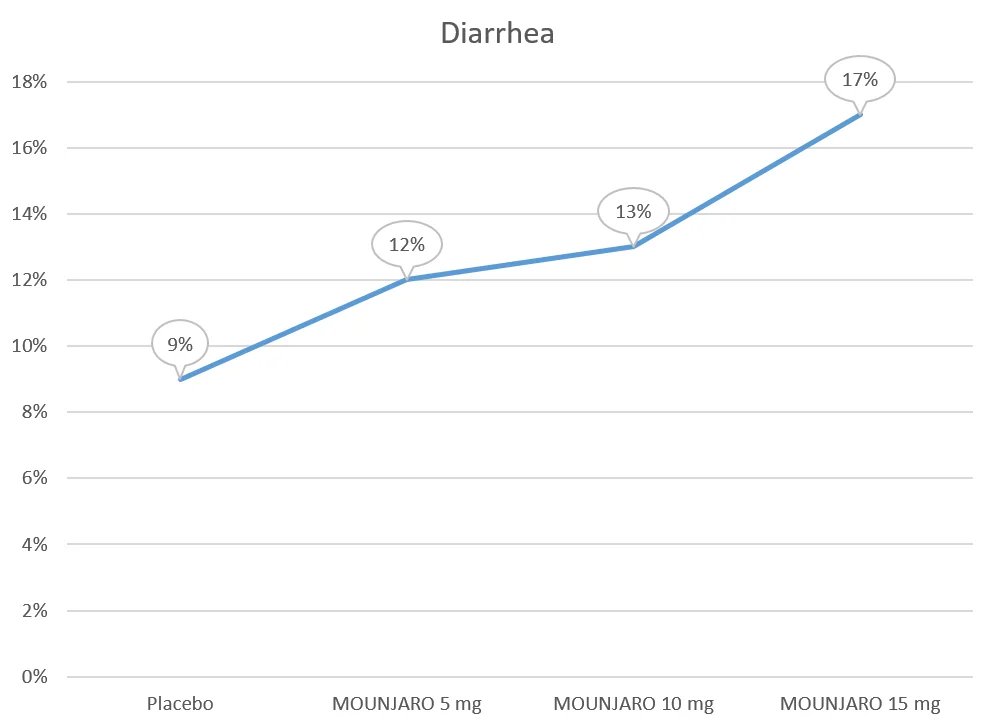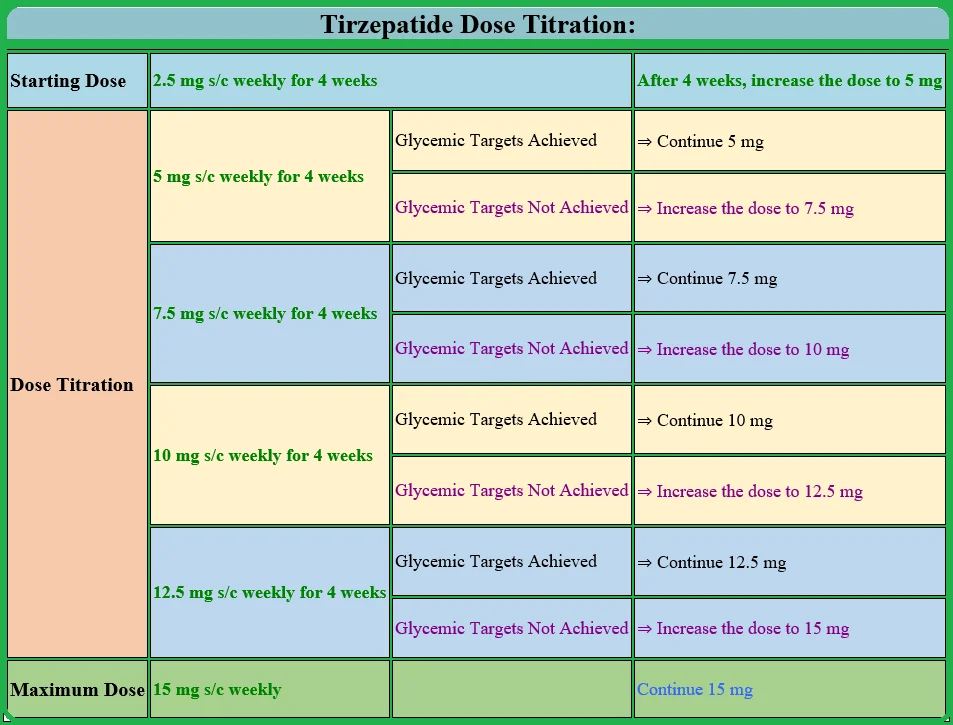“Mounjaro Diarrhea” is not a disease. It is a side effect of Mounjaro (Tirzepatide) which affects about 12 – 17% of Mounjaro users.
According to the FDA prescribing information, Diarrhea is one of the most common side effects of Mounjaro.
The other commonly reported side effects are:
- Nausea and vomiting
- Low appetite
- Constipation
- Indigestion and burping
- Stomach pain
| Read: |
How Frequent is Mounjaro Diarrhea?
Mounjaro diarrhea is a relatively common side effect of Tirzepatide. It affects 12% to 17% of the individuals who are using Mounjaro.
Although diarrhea can develop at times, it is commonly reported while escalating the dose from 2.5 to 5, 10, and 15 mg.
As per the FDA prescribing information, diarrhea was observed in the following percentages at the various doses:
Mounjaro Vs Placebo | Diarrhea |
| Placebo (N=235) | 9% |
| MOUNJARO 5 mg | 12% |
| MOUNJARO 10 mg | 13% |
| MOUNJARO 15 mg | 17% |

Diarrhea developing with Mounjaro use is dose-dependent. Most patients on Mounjaro develop diarrhea during the first week after dose up-titration.
In addition, higher doses are more likely to be associated with diarrhea than lower doses.
| Read: |
Why do people develop diarrhea when using Mounjaro?
Diarrhea may develop because of several reasons in diabetic patients, and patients using Mounjaro in particular.
“Mounjaro Diarrhea” – a direct effect of the drug:
Mounjaro acts directly on gut hormones. It enhances the effects of GIP (glucose-dependent Insulinotropic peptide) and GLP-1 (glucagon-like peptide).
Mounjaro reduces stomach movements. Hence most patients have sulfur burps along with diarrhea.
However, its effects on the intestines are variable. Diarrhea is commonly reported but some individuals develop constipation.
In addition, Mounjaro causes some degree of malabsorption which can also cause abdominal gases, bloating, and diarrhea.
IBS with Mounjaro:
IBS can co-exist in diabetic patients and patients using Mounjaro. Although, most patients get relief from gut symptoms when they start using Mounjaro or Ozempic.
In a group of 26 patients with IBS who were started on Mounjaro, 88% of them observed improvement in their symptoms. 2 patients developed worsening IBS symptoms while 1 patient developed diarrhea.
Here is a table summarizing the results:
| Impact of Mounjaro on the symptoms of IBS | |
| Symptoms of IBS Improved | 23 (88.5%) |
| IBS Symptoms Worsened | 2 (7.7%) |
| Developed IBS-D | 1 (3.8%) |
However, some patients do develop a flare-up of their symptoms. Individuals with IBS-D (IBS with predominant symptoms of diarrhea) may develop diarrhea that is more severe and does not get relieved with OTC medications used to treat diarrhea.
IBS with predominant diarrhea can develop and manifest as cramps, abdominal pain, bloating, incomplete evacuation, and anxiety.
Bacterial overgrowth:
Bacterial overgrowth or SIBO (small intestinal bacterial overgrowth) is another important cause of diarrhea, abdominal gases, and pain.
Because Mounjaro can slow gastric emptying, it may give more time for bacteria to multiply in the intestines.
Thus, after an initial period of constipation, people may develop abdominal gases, crampy pain, and diarrhea.
If you have developed diarrhea that is associated with abdominal gases, sulfur burps, and feverish feelings, you may benefit the most from cleansing your gut with gut antiseptics like Xifaxan (Rifaxamin).
In addition, individuals with SIBO and inflammation in the intestines may also notice that their diarrheal symptoms persist at night.
Nocturnal diarrhea is usually indicative of intestinal inflammation and should not be taken lightly.
| Read: |
How to Manage Mounjaro Diarrhea?

Managing diarrhea while using Mounjaro can be easy in mild cases. However, sometimes stopping Mounjaro treatment may be the only option in severe cases.
Here are some tips to manage “Mounjaro Diarrhea”:
Mounjaro Dose Titration”
“The race is not always to the swift“. Some people disregard their doctor’s advice and jump to a higher dose of Mounjaro without titrating up the dose as per recommendations.
This can lead to significant GI side effects including Diarrhea. This was observed in clinical trials too. Most people who developed diarrhea had it after dose escalation.
It is recommended to titrate the dose gradually every four weeks from 2.5 mg to 5, 7.5, 10, 12.5, and 15 mg.

Starting from a higher dose or jumping from a low dose to a higher dose in less than 4 weeks should be avoided. This will give time for your gut to adjust.
Some patients may still develop diarrhea despite following the recommendations and titrating the dose gradually.
In such cases, if the GI symptoms are intolerant, the dose of Mounjaro which is easily tolerated can be extended for more than 4 weeks. The same dose can be either continued or titrated up at a more gradual pace if required.
For example, a person tolerating Mounjaro 5 mg but not tolerating 7.5 mg can continue the 5 mg for 6 to 8 weeks and then try up-titrating it to 7.5 mg.
Changes in Diet:
Changes in diet can have a significant impact on the gut while using Mounjaro. Fluid intake should be increased to avoid dehydration.
It is important to avoid carbonated drinks and alcohol. BRAT diet that is blended and can be easily digested helps most people with Diarrhea while using Mounjaro.
Rice, applesauce, and bananas are usually part of the BRAT diet. Other helpful diets to help Mounjaro Diarrhera include Fenugreek seeds, peppermint oil, and ginger tea.
Probiotics for Mounjaro Diarrhea:
Diabetics and people using Mounjaro are at risk of developing bacterial overgrowth.
Probiotics are live yeasts and bacteria that normally live in the gut. Yeasts and non-pathogenic bacteria help in clearing harmful bacteria from the gut.
Thus, probiotics may help in relieving symptoms of bloating, gases, abdominal pain, and diarrhea in diabetics and obese individuals using Mounjaro.
| Read: |
OTC Medicines to Treat Mounjaro Diarrhea:
If Mounjaro Diarrhea does not settle with dose adjustment and lifestyle changes, before discontinuing the drug, one can try simple OTC available diarrhea medications.
The most commonly used are:
Both Loperamide and Bismuth are effective and safe. However, prolonged use of these medications should be avoided.
Prescription medicines to treat Mounjaro Diarrhea:
Prescription medications to treat diarrhea include:
- Antibiotics such as metronidazole, Rifaximin, and cephalosporins
- High dose Loperamide (Imodium)
- Viberzi and Truberzi (Eluxadoline)
- Alosetron
Although quinolones such as ciprofloxacin and levofloxacin are commonly used to treat diarrhea, they should be avoided because of their side effect profile.
In addition, these drugs may cause dysglycemia (fluctuations in the blood sugars) including hypoglycemia and hyperglycemia.
| Read: |




